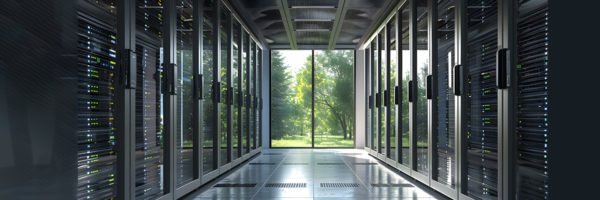Improving Data Center Sustainability With Cisco MDS 9000 Transceiver Power-Control Capability
By Fausto Vaninetti and Ramesh Raghavan
Published 05-30-25
Submitted by Cisco Systems, Inc.

In the fast-paced evolution of data centers, the spotlight on sustainability has never been brighter. As energy demands surge, finding innovative ways to reduce energy consumption becomes crucial. The transceiver power-control feature within Cisco MDS 9000 switches helps architecting sustainability in storage area networks and contributes to the broader goal of creating more environmentally responsible and cost-effective data center operations.
The Power Challenge in Data Centers
Modern data centers face a formidable challenge in managing escalating power demands. The sheer volume of servers, networking equipment, and storage arrays requires a substantial energy supply, leading to increased operational costs and a larger carbon footprint. The boom of Artificial Intelligence (AI) workloads and their power-hungry underlying infrastructure has changed trajectory and further exacerbated the situation. Addressing this challenge has become imperative for organizations striving for sustainability.
In the journey toward net zero, Scope 2 greenhouse gas (GHG) emissions present a major hurdle for data center operators. With IT gear and network devices operating 24×7, their usage phase is the main contributor to GHG emissions. For network devices, the power demand of optical transceivers continues to rise. An SFP+ transceiver can reach 1.5 Watts, while a QSFP-DD transceiver can exceed 16 Watts. As a result, optical transceivers account for a significant portion of the energy consumption in modern switches and routers. In a typical 1RU switch, optical transceivers could represent 16% or more of its energy consumption under standard operating conditions.
Understanding Transceiver Power-Control Feature
Cisco MDS switches harness the advantages of the transceiver power-control feature to achieve a harmonious balance between performance and energy efficiency. This new capability represents an innovation for the entire industry. Organizations can experience a notable reduction in energy costs, contributing to operational savings while simultaneously lessening their environmental impact.
Typically, when optical transceivers are inserted into switch ports and a user administratively shuts down a specific port, the switch only disables the laser without cutting off power to the optical transceiver. This means that when the port is shut down, the optical transceiver still draws significant power despite a slight reduction.
Starting with Cisco MDS 64G platforms (DS-X9748-3072K9, MDS 9124V, MDS 9148V, and MDS 9396V), there is an SFP FPGA hardware support for controlling power to the transceiver at the per-port level. The transceiver power-control feature utilizes this hardware capability to turn off the power to the transceiver when a port is administratively shutdown. Upon an administrator performing a ‘no shutdown’ on a port, the power is restored to that transceiver. Older Cisco MDS platforms, as well as competitive solutions, do not have this hardware capability and cannot turn off the power when a port is administratively down.
With Cisco MDS NX-OS Release 9.4(2) onwards, the transceiver power-control feature is available and enabled by default on all MDS 64G platforms. With this feature, ports are always-ready, not always-on. In other words, a port is always ready to be powered up, but when administratively down, the port would stay powered off and consume no energy.
Lab tests show that 34 Watts of power are saved for 24 ports in the admin down state with their short-wave transceiver being powered off. Higher savings are achieved with long-wave transceivers.
One practical scenario sees a customer with 6000 ports having 20% of spare ports. The transceiver power-control feature leads to about 1680W saved, equivalent to 14717 kWh/year. For a data center with PUE = 1.5 and assuming 0,27 euro/kWh, this translates into 5960 euro of savings in the energy bill each year.
One feature, many benefits
The transceiver power-control feature is an example of static power control, well-suited for networking devices, where planning for additional connectivity is possible. Customer evidence shows that spare ports account for 10% to 50% of all installed switching ports, indicating that transceiver power-control could drive substantial energy savings.
The transceiver power-control feature has many benefits, including:
- Up to 32% energy savings for a switch
- easy operations with remote settings for power control
- full real-time inventory even for interfaces that are administratively shut (power off), leveraging a highly engineered flow of operations within NX-OS software
- high reliability under power cycles and without an impact on failure rates, achieved by optimized design and tight qualification of Cisco SFPs
- SFP agnostic operation, applicable to any type of SFP qualified on 64G devices
- ubiquitous operation on both 64G switches and director line cards
- faster restart to avoid any delay for reaching mission mode on links
- included in the base offering at no additional cost
Enabling/Disabling Transceiver Power-Control Feature
The transceiver power-control feature is enabled by default on Cisco MDS 64G fibre channel switches. The feature can be turned on using the following CLI command:
Enable/disable status of the feature can be viewed using the below CLI command.
Transceiver power status for each port is displayed in the “show interface” CLI command output. In the example below, interface fc1/3 shows that transceiver power-control feature is enabled, and the port is administratively shut. As a result, its power would be zero.
Conclusion
The deployment of Cisco MDS switches supporting the transceiver power-control feature represents a proactive step towards creating more sustainable and cost-effective data center operations. The potential benefits include energy savings, reduced energy bills, improved compliance with environmental standards, and a positive contribution to a more sustainable future.
View original content here.

Cisco Systems, Inc.
Cisco Systems, Inc.
About Cisco
Cisco (NASDAQ: CSCO) is the worldwide leader in technology that powers the internet. Cisco inspires new possibilities by reimagining your applications, securing your data, transforming your infrastructure, and empowering your teams for a global and inclusive future. Discover more on The Network and follow us on Twitter.
About Cisco's Purpose
Cisco’s purpose is to Power an Inclusive Future for All. From increasing access to skills needed to thrive in a digital economy to supporting the most vulnerable in times of crisis, we’re committed to using our technology for good. Cisco is also leveraging our scale and innovation to help ensure that our increasingly digital future is sustainable, inclusive, and resilient.
More from Cisco Systems, Inc.

